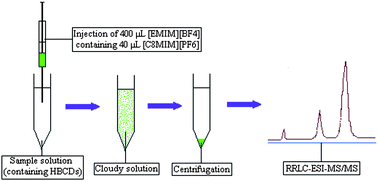Ionic liquid/ionic liquid dispersive liquid–liquid microextraction, a new sample enrichment procedure for the determination of hexabromocyclododecane diastereomers in environmental water samples
Abstract
In this paper, a new

* Corresponding authors
a
Key laboratory for applied technology of sophisticated analytical instruments of Shandong province, Analysis and Test Center, Shandong Academy of Sciences, Jinan, China
E-mail:
zhaors1976@126.com
Fax: +86-531-82964889
In this paper, a new

 Please wait while we load your content...
Something went wrong. Try again?
Please wait while we load your content...
Something went wrong. Try again?
R. Zhao, X. Wang, L. Zhang, S. Wang and J. Yuan, Anal. Methods, 2011, 3, 831 DOI: 10.1039/C0AY00708K
To request permission to reproduce material from this article, please go to the Copyright Clearance Center request page.
If you are an author contributing to an RSC publication, you do not need to request permission provided correct acknowledgement is given.
If you are the author of this article, you do not need to request permission to reproduce figures and diagrams provided correct acknowledgement is given. If you want to reproduce the whole article in a third-party publication (excluding your thesis/dissertation for which permission is not required) please go to the Copyright Clearance Center request page.
Read more about how to correctly acknowledge RSC content.
 Fetching data from CrossRef.
Fetching data from CrossRef.
This may take some time to load.
Loading related content
